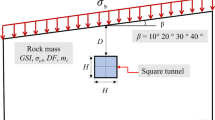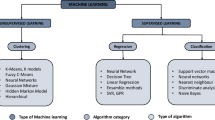Abstract
Construction of subsea tunnels has grown significantly in recent decades around the world. Hence, ensuring the stability of these tunnels is very important. However, investigating the stability of subsea tunnels has not received enough attention. The goal of the present study is to use the finite element limit analysis (FELA) for determining the internal pressure needed to maintain the stability of circular subsea tunnels embedded in a Tresca material by considering various values for the influential parameters. The problem was modeled and investigated in a plane strain condition. It was observed that the required internal pressure, in a dimensionless form, increased linearly by increasing soil cover and water depth. The failure mechanism was also investigated. It was observed that although the water depth did not have a considerable effect on the failure type, the mechanism did not cover the tunnel’s roof for lower values of soil cover and soil’s undrained shear strength. Both the adaptive neuro-fuzzy inference system (ANFIS) and the multiple linear regression (MLR) were implemented to predict the required dimensionless internal pressure. The performance of both methods was assessed by using multiple statistical measures such as the root-mean-square-error and the Bland-Altman plot. It was observed that the predictive capability of the ANFIS was far better than the MLR.











Similar content being viewed by others
Data availability
The data that support the findings of this study are available from the corresponding author, upon reasonable request.
References
Abbo AJ, Wilson DW, Sloan SW, Lyamin AV (2013) Undrained stability of wide rectangular tunnels. Comput Geotech 53:46–59. https://doi.org/10.1016/j.compgeo.2013.04.005
Altman DG, Bland JM (1983) Measurement in medicine: the analysis of method comparison studies. J Royal Stat Soc Ser D: Stat 32(3):307–317
Arabpour Roghabadi M, Momeni M, Zangenehmadar Z (2021) Prediction of standard penetration test N-value from dynamic probing light N-value using ANFIS and multiple regression models. Int J Geotech Eng 15(6):740–745. https://doi.org/10.1080/19386362.2018.1498578
Azeem MF (2012) Fuzzy inference system: theory and applications. BoD–Books on Demand
Bland JM, Altman D (1986) Statistical methods for assessing agreement between two methods of clinical measurement. Lancet 327(8476):307–310
Broms BB, Bennermark H (1967) Stability of clay at vertical opening. J Soil Mech Found Div 93(1):71–94
Buckingham E (1914) On physically similar systems; illustrations of the use of dimensional equations. Phys Rev 4(4):345
Cabalar AF, Cevik A, Gokceoglu C (2012) Some applications of adaptive neuro-fuzzy inference system (ANFIS) in geotechnical engineering. Comput Geotech 40:14–33. https://doi.org/10.1016/j.compgeo.2011.09.008
Chen R-p, Li J, Kong L-g, Tang L-j (2013) Experimental study on face instability of shield tunnel in sand. Tunn Undergr Space Technol 33:12–21. https://doi.org/10.1016/j.tust.2012.08.001
Chiu SL (1994) Fuzzy model identification based on cluster estimation. J Intell Fuzzy Syst 2(3):267–278
Di Q, Li P, Zhang M, Zhang W, Wang X (2022) Analysis of face stability for tunnels under seepage flow in the saturated ground. Ocean Eng 266:112674. https://doi.org/10.1016/j.oceaneng.2022.112674
Fu Y, Zeng D, Xiong H, Li X, Chen Y (2022) Seepage effect on failure mechanisms of the underwater tunnel face via CFD–DEM coupling. Comput Geotech 146:104591. https://doi.org/10.1016/j.compgeo.2021.104591
Guo P, Gong X, Wang Y, Lin H, Zhao Y (2021) Minimum cover depth estimation for underwater shield tunnels. Tunn Undergr Space Technol 115:104027. https://doi.org/10.1016/j.tust.2021.104027
Jang J-S (1993) ANFIS: adaptive-network-based fuzzy inference system. IEEE Trans Syst Man Cybernetics 23(3):665–685
Ke L, Gao Y, Li D, Zhang J, Ji J (2020) Undrained stability analysis of trenches for buried submarine pipelines. Mar Georesources Geotechnology 38(5):583–594. https://doi.org/10.1080/1064119X.2019.1604918
Krabbenhoft K, Lyamin A, Krabbenhoft J (2015) Optum computational engineering (OptumG2). Computer Software
Kumar DR, Samui P, Wipulanusat W, Keawsawasvong S, Sangjinda K, Jitchaijaroen W (2023) Machine learning approaches for prediction of the bearing capacity of ring foundations on rock masses. Earth Sci Inf 1–16. https://doi.org/10.1007/s12145-023-01152-y
Lai VQ, Chauhan VB, Keawsawasvong S, Sangjinda K, Chavda JT, Mase LZ (2023) An extreme learning neural network approach for seismic bearing capacity estimation of planar caissons in nonhomogeneous clays. Earth Sci Inf 1–20. https://doi.org/10.1007/s12145-023-01175-5
Leca E, Dormieux L (1990) Upper and lower bound solutions for the face stability of shallow circular tunnels in frictional material. Géotechnique 40(4):581–606
Li P-f, Zhou X-j (2015) Mechanical behavior and shape optimization of lining structure for subsea tunnel excavated in weathered slot. China Ocean Eng 29:875–890. https://doi.org/10.1007/s13344-015-0061-8
Li W, Zhang C, Tan Z, Ma M (2021) Effect of the seepage flow on the face stability of a shield tunnel. Tunn Undergr Space Technol 112:103900. https://doi.org/10.1016/j.tust.2021.103900
Lü X, Zhou Y, Huang M, Zeng S (2018) Experimental study of the face stability of shield tunnel in sands under seepage condition. Tunn Undergr Space Technol 74:195–205. https://doi.org/10.1016/j.tust.2018.01.015
Mair RJ (1980) Centrifugal modelling of tunnel construction in soft clay. Ph. D Thesis, University of Cambridge
Miyaguchi K (1986) Maintenance of the Kanmon railway tunnels. Tunn Undergr Space Technol 1(3–4):307–314
Moradi F, Bonakdari H, Kisi O, Ebtehaj I, Shiri J, Gharabaghi B (2019) Abutment scour depth modeling using neuro-fuzzy-embedded techniques. Mar Georesources Geotechnology 37(2):190–200. https://doi.org/10.1080/1064119X.2017.1420113
Muir Wood A, Wood A, Brunel M (1994) The Thames, tunnel 1825-43 : where shield tunnelling began. In: Proceedings of the Institution of Civil Engineers-Civil Engineering 102:130–139. Thomas Telford-ICE Virtual Library
Nilsen B (2014) Characteristics of water ingress in Norwegian subsea tunnels. Rock Mech Rock Eng 47:933–945. https://doi.org/10.1007/s00603-012-0300-8
Nilsen B, Palmstrϕm A (2017) Stability and water leakage of hard rock subsea tunnels modern tunneling science and technology. In: Modern tunneling science and technology. Routledge, pp 497–502
Palmström A (1994) The challenge of subsea tunnelling. Tunn Undergr Space Technol 9(2):145–150. https://doi.org/10.1016/0886-7798(94)90025-6
Panet M (1993) Understanding deformations in tunnels. Comprehensive Rock Engineering, Vol. 1. Pergamon Press
Perazzelli P, Leone T, Anagnostou G (2014) Tunnel face stability under seepage flow conditions. Tunn Undergr Space Technol 43:459–469. https://doi.org/10.1016/j.tust.2014.03.001
Ross TJ (2009) Fuzzy logic with engineering applications. Wiley
Sahoo JP, Kumar B (2019) Support pressure for stability of circular tunnels driven in granular soil under water table. Comput Geotech 109:58–68. https://doi.org/10.1016/j.compgeo.2019.01.005
Schofield AN (1980) Cambridge geotechnical centrifuge operations. Geotechnique 30(3):227–268
Shafiee AH, Eskandarinejad A (2022) Bearing capacity of single stone column in clay using finite element limit analysis. Eur J Environ Civil Eng 26(15):7958–7971. https://doi.org/10.1080/19648189.2021.2019616
Sloan S (2013) Geotechnical stability analysis. Géotechnique 63(7):531–571
Sloan S, Assadi A (1992) Stability of shallow tunnels in soft ground. In: Predictive soil mechanics: Proceedings of the Wroth Memorial Symposium held at St Catherine’s College, Oxford, 27–29 July 1992. Thomas Telford Publishing, p 644–663
Song S-G, Li S-C, Li L-P et al (2016) Study on longitudinal deformation profile of rock mass in a subsea tunnel. Mar Georesources Geotechnology 34(4):376–383. https://doi.org/10.1080/1064119X.2015.1012314
Song X, Cui S, Tan Y, Zhang Y (2022) Influence of water pressure on deep subsea tunnel buried within sandy seabed. Mar Georesources Geotechnology 40(8):967–982. https://doi.org/10.1080/1064119X.2021.1961954
Takagi T, Sugeno M (1983) Derivation of fuzzy control rules from human operator’s control actions. IFAC Proc Volumes 16(13):55–60
Wilson DW, Abbo AJ, Sloan SW, Lyamin AV (2013) Undrained stability of a square tunnel where the shear strength increases linearly with depth. Comput Geotech 49:314–325. https://doi.org/10.1016/j.compgeo.2012.09.005
Xue Y, Zhou B, Qiu D et al (2019) A prediction model for overlying rock thickness of subsea tunnel: a hybrid intelligent system. Mar Georesources Geotechnology 37(10):1267–1276. https://doi.org/10.1080/1064119X.2018.1550544
Zadeh LA (1965) Fuzzy sets. Inf Control 8(3):338–353
Funding
The authors declare that no funds, grants, or other support were received during the preparation of this manuscript.
Author information
Authors and Affiliations
Contributions
The conceptualization and preparation of the manuscript was performed by A.H.S and M.O. The analyses were performed by M.A. The final submitted manuscript was scrutinized and approved by all authors.
Corresponding author
Ethics declarations
Competing interests
The authors declare no competing interests.
Additional information
Communicated by: H. Babaie
Publisher’s Note
Springer Nature remains neutral with regard to jurisdictional claims in published maps and institutional affiliations.
Appendix
Appendix
The number of independent variables (Nv) was equal to six including D, hw, hs, Cu, γ, and σt.
The reference dimensions of the variables are: D \(\stackrel{.}{=}\) [L], hw \(\stackrel{.}{=}\) [L], hs \(\stackrel{.}{=}\) [L], Cu \(\stackrel{.}{=}\) [FL−2]; γ \(\stackrel{.}{=}\) [FL−3]; and σt \(\stackrel{.}{=}\) [FL−2], where F and L are the dimensions of the force and the length, respectively; and the notation \(\stackrel{.}{=}\) shows the dimension of the variable. Hence, the number of reference dimensions (ND) is equal to two including F and L.
The Buckingham’s Pi theorem (Buckingham 1914) indicates that the number of dimensionless products (Np) is 6–2 = 4. The authors selected the variables D and Cu as repeating variables.
For determining the first dimensionless product (π1), σt was selected as the nonrepeating variable. So:
Since π1 is dimensionless:
Setting the power terms to zero leads to:
In the next step, we considered γ to obtain the second dimensionless variable (π2) as follows:
As a result:
As a result: \(1+d=0\), and \(-3+c-2d=0\). The resulting dimensionless product is:
Using hw for obtaining the third dimensionless product (π3) leads to:
Since π3 is dimensionless:
The above equation leads to: β = 0, and α = −1. Consequently:
Since hs has the same dimension as hw, the fourth dimensionless product (π4) is:
Rights and permissions
Springer Nature or its licensor (e.g. a society or other partner) holds exclusive rights to this article under a publishing agreement with the author(s) or other rightsholder(s); author self-archiving of the accepted manuscript version of this article is solely governed by the terms of such publishing agreement and applicable law.
About this article
Cite this article
Shafiee, A.H., Oulapour, M. & Abdlkadhim, M.A.A. Stability of subsea circular tunnels using finite element limit analysis and adaptive neuro-fuzzy inference system. Earth Sci Inform (2024). https://doi.org/10.1007/s12145-024-01287-6
Received:
Accepted:
Published:
DOI: https://doi.org/10.1007/s12145-024-01287-6




